General Content
This article will introduce the city’s earliest hospitals. It is my hope that by remembering these institutions in this forum, we continue to honor the past service of the individuals who served the people of Rochester, in these hospitals, as well as the present generation who continued to serve this community.
The origin of medical care in Rochester can be traced back to the early days of the nineteenth-century when Rochester was America’s newest “Boom” town. Dr. Jonah Brown was the first physician to settle in Rochester around 1813. Over the following two decades, Rochester grew rapidly as the center of commerce in Western New York. The first recorded community institution where medical care was offered was organized in 1826 on South Avenue as the Almshouse. The Almshouse was created in response to the increase in population and in particular, the communities poor, who came to region to find work on the Erie canal or one of the many commercial interests that were created in response to the economic growth brought about by the Canal and the milling industry.
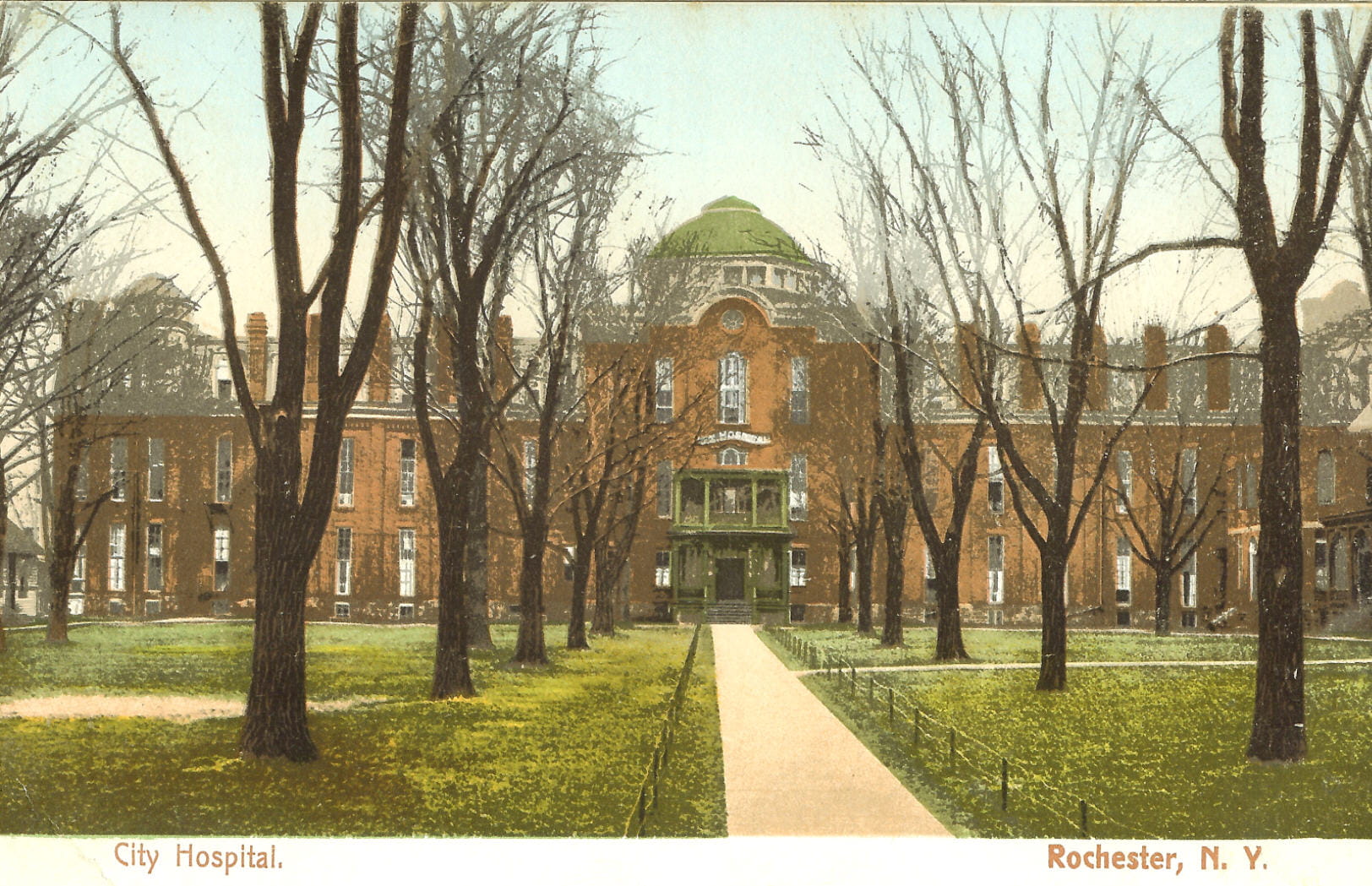
The growth in commerce resulted in increased population and along with the influx of canal workers, merchants, and migrants moving west came communicable diseases such as cholera, malaria, scarlet fever, and small pox. The rise in deaths and illness from disease and poverty prompted a group of Rochester’s women to form the Rochester Female Charitable Society in 1822 to expressly serve the community’s poor. A quarter-century later it would be this organization of women aided by a group of community and business leaders who petitioned the State officials in Albany for a hospital charter. Granted a charter in 1847, it would take another twelve years to convince the community of its necessity and raise the necessary funds to begin construction on what would become the Rochester City Hospital. Opening on January 28, 1864, the City Hospital was located on the grounds of the former Buffalo Street Cemetery along what today is West Main Street. The hospital began its long service to Rochester by treating wounded Civil War soldiers and would continue to serve up to the present. In 1911 the hospital changed its name to Rochester General Hospital to more accurately reflect its mission of providing a wide range of medical services. The twentieth-century was a time of prodigious growth for the hospital serving through two World Wars and evolving into one of the country’s foremost Cardiac hospitals.
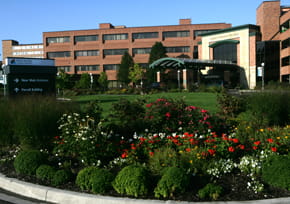
Today Rochester General Hospital is the flagship of the Rochester General Health System. It is a multi-specialty 528-bed tertiary facility that is recognized as one of the nation's top cardiac centers. Additionally it enjoys the highest JCAHO accreditation and Magnet Nursing status. As the flagship of the health system, Rochester General is affiliated with the Newark-Wayne Community Hospital and the Demay Living Center in Newark New York, a comprehensive Behavioral Health Network, a skilled Nursing home at Hill Haven, an independent Living for Seniors facility and the Rochester General Medical Group offering a network of 41 primary care and specialized physician practices throughout the region. The systems outside affiliations include the recognized top cardiac hospital in the nation, the Cleveland Clinic and the Roswell Park Cancer Institute. Although the City hospital was the first organized hospital in Rochester, it was not the first to open its doors and provide medical treatment to the citizens of Rochester.
In September of 1857, three nuns of the Catholic Daughters of Charity order established St. Mary’s Hospital in a couple of one room stone stables located at the intersection of Genesee Street and West Main Street. In 1857 the Bishop of Buffalo - Rochester diocese, Bishop John Timon, attempted to raise interest in establishing a permanent hospital in Rochester. His previous attempt had failed but was successful in securing the help of two men from St. Patrick’s parish. Doctor Thomas Bradley and Mr. Patrick Berry chose the site for the hospital and the diocese purchased the site for $1,300.00 and on September 8, 1857, the hospital was established. Bishop Timon requested from the Daughter’s of Charity of Emmitsburg, Maryland three sisters to staff the hospital. They arrived shortly after the opening and they were Mother (Sister) Hieronymo (Latin for Jerome) O’Brien, Sister Martha Bridgeman, and Sister Felicia Fenwick. These ladies, along with the members of St. Patrick’s parish went to work organizing the structures and on September 15th the first patients were admitted.
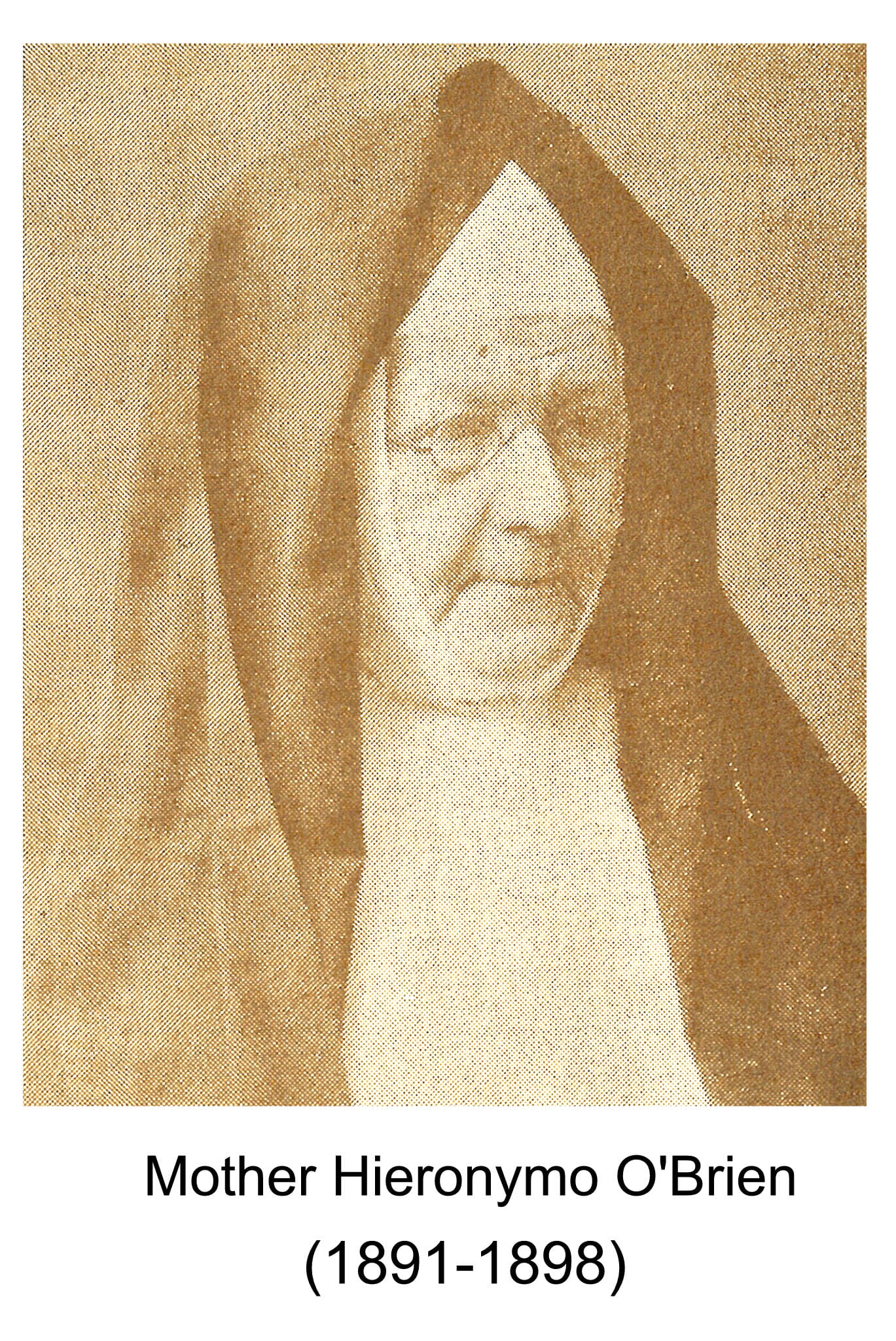 The hospital under Sister Hieronymo’s leadership quickly improved and expanded to meet the challenges confronting it. In 1859, the large three-story East wing was constructed on Genesee Street and four years later in 1863, the permanent main hospital was opened on the north-west corner of West Main Street. The U.S. Government called on communities to aid in treating wounded soldiers in the summer of 1861 as the country was shaken by the opening clashes of the Civil War. St. Mary’s Hospital began receiving wounded soldiers in 1861 and would eventually be designated as a U.S. General Hospital in 1863. Over the four years of the war, both Rochester City hospital and St. Mary’s treated wounded federal and confederate soldiers but it was St. Mary’s hospital that would hold the designation as an “Official U.S. Army General Hospital” and cared for 2,500 soldiers.
The hospital under Sister Hieronymo’s leadership quickly improved and expanded to meet the challenges confronting it. In 1859, the large three-story East wing was constructed on Genesee Street and four years later in 1863, the permanent main hospital was opened on the north-west corner of West Main Street. The U.S. Government called on communities to aid in treating wounded soldiers in the summer of 1861 as the country was shaken by the opening clashes of the Civil War. St. Mary’s Hospital began receiving wounded soldiers in 1861 and would eventually be designated as a U.S. General Hospital in 1863. Over the four years of the war, both Rochester City hospital and St. Mary’s treated wounded federal and confederate soldiers but it was St. Mary’s hospital that would hold the designation as an “Official U.S. Army General Hospital” and cared for 2,500 soldiers.
The late nineteenth-century was a time of great progress in the nation as well as here in Rochester. On the Night of February 15, 1891, a fire destroyed the majority of the main building, the Chapel, Women’s Ward, Surgical Ward, and many private rooms. The community came to the aid of the hospital and raised the necessary funds to rebuild the hospital on its site facing West Main Street. This building would be replaced in 1943 with the present structure facing east on Genesee Street. The decades witnessed the hospital continue to expand and evolve to meet the needs of the community. In 1892 the Training School of Nurses opened, the Maternity Department was established in 1903, and the Out-Patient department began in 1923.
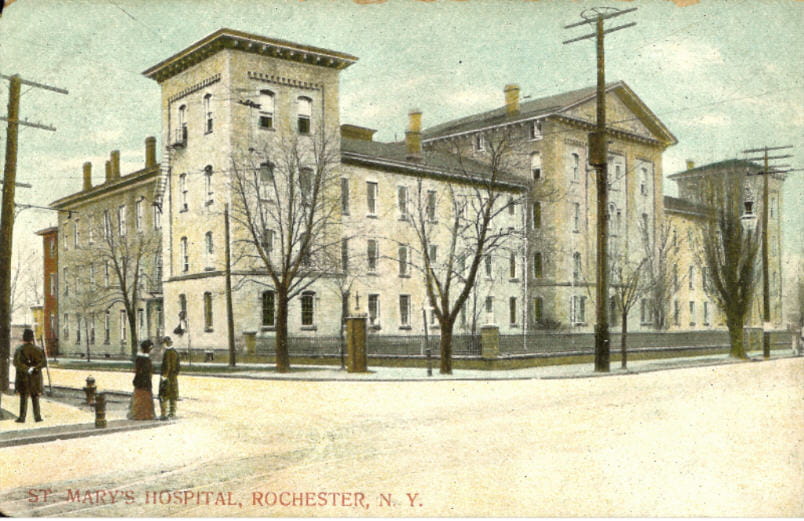
In 1996, the hospital was awarded the prestigious Foster G. McGaw prize for Community Service. Two years later, St. Mary’s aligned with Park-Ridge Hospital to form the Unity Health System and consequently, its mission was changed to focus on full-time out-patient services. Today, St. Mary’s Hospital remains a valued member of Rochester’s medical community.
In 1826, Monroe County established an Alms house to care for the growing population of poor in the community. The beginning of construction of the Erie Canal in 1817 attracted many skilled and unskilled laborers in search of jobs. The increased commerce and competition for work fueled the rise in poverty and the indigent. By the late 1850s, a separate wing was constructed to house the mentally insane and the steady increase in patients precipitated the construction of a separate building on South Avenue. This new facility was named the Monroe County Insane Asylum.
The rising concern over the care of the mentally insane prompted the New York State legislature to pass legislation that provided the funding of state hospitals to care for these patients. In July of 1891 the Monroe County Insane Asylum’s named was changed to the Rochester New York State Hospital.
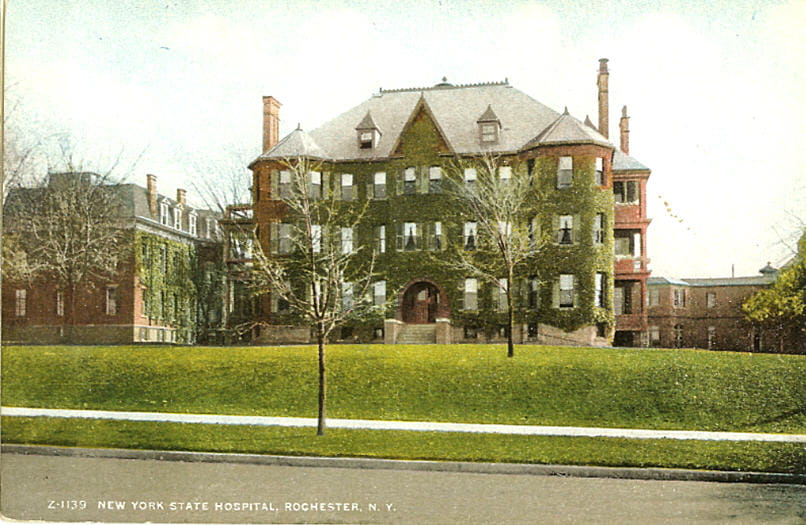
That same year, the hospital incorporated a Training School for Nurses that operated until 1973. The name of the institution was changed to the Rochester Psychiatric Center in 1974 and continues to serve the Rochester community. The original Almshouse continued to operate and shares roots of its origin with the Monroe County Insane Asylum and today continues as the Monroe Community Hospital.
The Almshouse on South Avenue remained the sole caregiver to the communities poor until the establishment of St. Mary’s and the City Hospital.
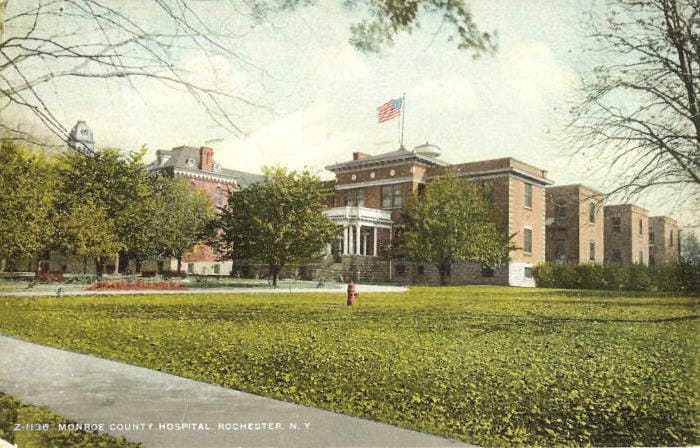
By the early twentieth-century, over crowding and concerns over fire safety prompted the county government to construct a full sized hospital. The new facility, named the Monroe Community Home and Infirmary, was located at the corner of Westfall Road and East Henrietta Road and opened on August 1, 1933. Its medical focus was the care and rehabilitation of the chronically ill. Between the 1930s and 1950s, the institution primarily served as a General Hospital, providing medical, surgical, maternity, pediatric, and dental care for the impoverished. In 1967, the name was changed to the Monroe Community Hospital for the Care of the Chronically Ill to better reflect its shift to treating the elderly population. Around 1968, the name was shortened to Monroe Community Hospital. The hospital remains today as an important health care provider in the Rochester Community.
In the years after the civil war leading up to the First World War, many private and specialty hospitals were established to serve specific groups of patients. Rochester hosted a municipal hospital and several private hospitals that specialized in the treatment of children, the mentally ill, and patients of contagious diseases. The first of these began as a group of buildings behind St. Mary’s Hospital and eventually become part of the Strong Memorial Hospital.
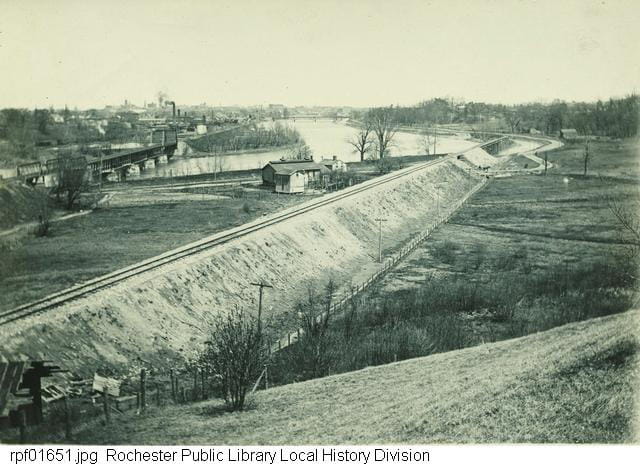
What would become Hope Hospital was first referred to as the “Pest House” and was used for the quarantine of patients with infectious diseases. It was located on Clifton Street behind St. Mary’s Hospital. Its primary use was to quarantine contagious disease patients, such as soldiers suffering from smallpox after returning from the Civil War. The premises were inspected by members of the Board of Aldermen of the City of Rochester in 1868 and found it to be “a disgrace to the city, and is inadequate to the wants of the sick.” The report of the committee recommended the purchase and establishment of a new facility south of the city. Later that year, a location behind the Mount Hope Cemetery along the Genesee River flats was found suitable for the new hospital. Originally known as the Rapids Hospital, but by December 1868, the name was changed to Hope Hospital. The location consisted of a 40 year old, two-story farm house and two erected wards capable of housing 16 patients. Its location on the east side of the Genesee River was susceptible to flooding and had only one shallow well as a water source and was closely situated beside the Lehigh Valley Railroad tracks. The location is presently occupied by the University of Rochester River campus.
The first full-time Rochester City Health officer described the new facility as “a two-ward and one-room, sixteen bed hospital with one water tap in the kitchen, without a sewer, an old, partitioned privy in back labeled ‘Ladies”, “Gents’, a two-room, battered, unpainted shack for isolating suspects and an old grocery wagon for an ambulance- the horse had to be rented.” Later it would be outfitted by a single telephone. Rochester’s Health Officer, Dr. George W. Goler, remarked that it remained inadequate for its purposes until its relocation in first years of the new century.
The small-pox epidemic of 1902-03 precipitated the expansion of the hospital to combat the gradual increase of patients. The deplorable conditions prompted the addition of many tents, improved sanitation, and better administrative management to combat the influx of patients. By the spring of 1903, plans for a new municipal hospital north of the city eventually resulted in the burning of remnants of the Pest House at Hope Hospital.
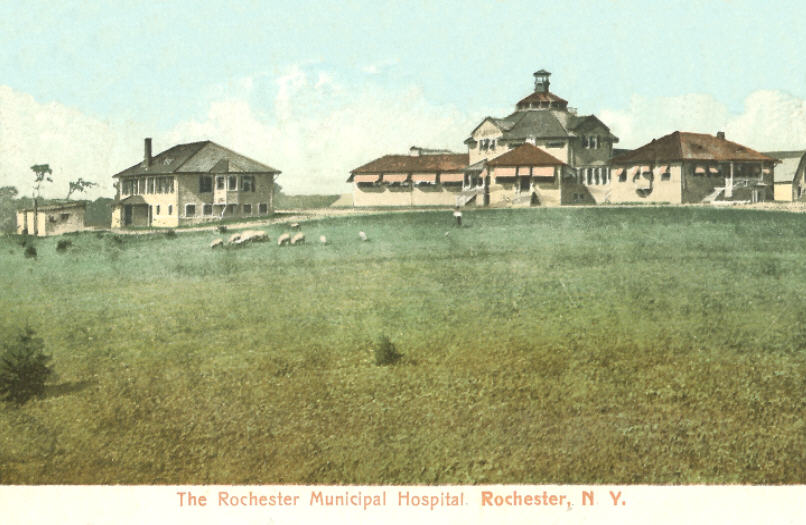
The new location of what was now called the Rochester Municipal Hospital was at the intersection of Culver and Waring roads on the present location of Frederick Douglass Junior High School. It was opened in 1903 with 100 beds as an isolation hospital contagious diseases, primarily tuberculosis. It operated at this location until 1926 when a new 300 bed municipal hospital was constructed adjoining Strong Memorial hospital on Crittenden Blvd.
An investigation into claims of abuse and mismanagement of the Hope Hospital was convened in February 1903 by the Public Safety Committee of the City Common Council. Charges of neglect and incompetence were directed at the City Health Officer, Dr. Goler and his assistant and administrator of Hope Hospital, Dr. William M. Barron. The final report of the committee called for the dismissal of Goler and Barron, but the political climate of the city prevented their dismissal. Supporters of Goler and the Health Department argued that Goler had called for better facilities and adequate funding before the epidemic but was ignored and the health department did the best they could with the resources provided them by the city government. Dr. Goler would continue and have a distinguished career as the City Health Officer retiring in 1932.
The growth of multiple community hospitals and the advancement of medicine ultimately forced the closing of the municipal hospital and it would eventually be absorbed into the Strong Memorial Hospital in the 1960s. Another hospital that specialized in the treatment of children began as a collection of tents along Lake Ontario’s shore.
In the summer of 1887, the rise in infant deaths and children’s disease from contaminated wells, stagnant sewers and poor sanitation prompted the establishment of the Infant’s Summer Hospital on the shores of Lake Ontario. The hospital was formed by Doctor Edward M. Moore, M.D. on Beach Avenue in Charlotte and primarily for children up to the age of 15 years. Initially, the patients were housed in tents in the hopes that the better circulation of “healthful Lake Breezes” would reduce the deaths from diseases. It is now thought that the increase in infant deaths were the result of improper pasteurization and refrigeration of milk.
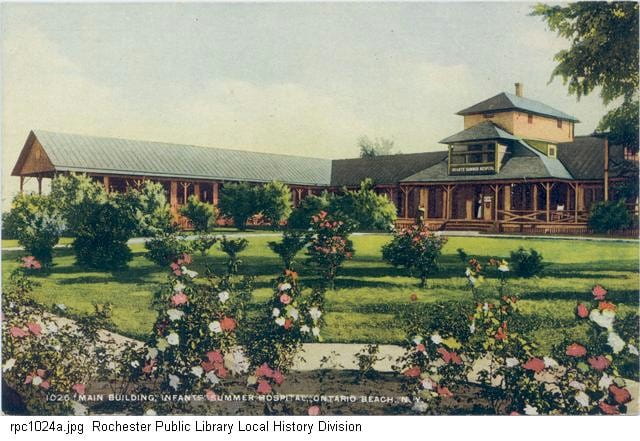
By 1890, the hospital expanded its service to children by including care for patients with long-term convalescent care from conditions such as malnutrition and rheumatic heart. The improvised tent city was replaced with the construction of a wooden structure starting in 1892. The hospital continued to grow with the generous support of the community. Around 1913, $100,000 was raised for the construction of a permanent structure for the Infant’s Summer Hospital at 425 Beach Avenue. This building remains today as the Shore Winds Nursing Home on Beach Avenue.
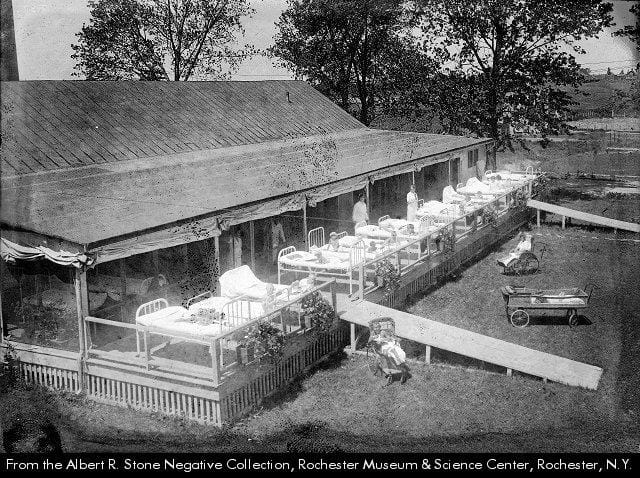
By 1928, the hospital’s name was changed to the Convalescent Hospital for Children due to the improved condition in urban sanitation and the expanded scope of its medical care. That same year the hospital extended its months of operation to year round in response to the needs of the community. In 1959, the CEO of the Genesee Brewery, John Wehle, donated land on Scottsville Road for a new facility and construction began. The hospital was moved to its present location on Scottsville road in 1960. In 1991, the name was changed again to the Crestwood Children’s Center. The name Crestwood symbolizes the bridge between the past and future: “Crest” represents being on the cutting edge and “wood” symbolizes the past built on strength and security. Today, Crestwood is an affiliate of Hillside Family of Agencies in Rochester. The next hospital in this brief chronicle continues today as Unity Hospital in Greece New York.
The origin of Park Avenue Hospital began in 1894 when Dr. John F.W. Whitbeck, a respected Rochester Surgeon and physician at the Rochester City Hospital, commissioned the construction of a three-story brick building on the south-west corner of Park Avenue and Brunswick Street. The twenty-five bed hospital operated for about ten years before closing due to financial insolvency. The building that was referred to as Dr. Whitbeck’s Hospital was converted into a private school for boys in 1904 by J. Howard Bradstreet. Mr. Bradstreet’s school lasted until 1907 when the school was relocated and the building was purchased from Dr. Whitbeck by Dr. Charles R. Barber who, after remodeling, opened the renamed 40 bed hospital as the Park Avenue Hospital in 1908.
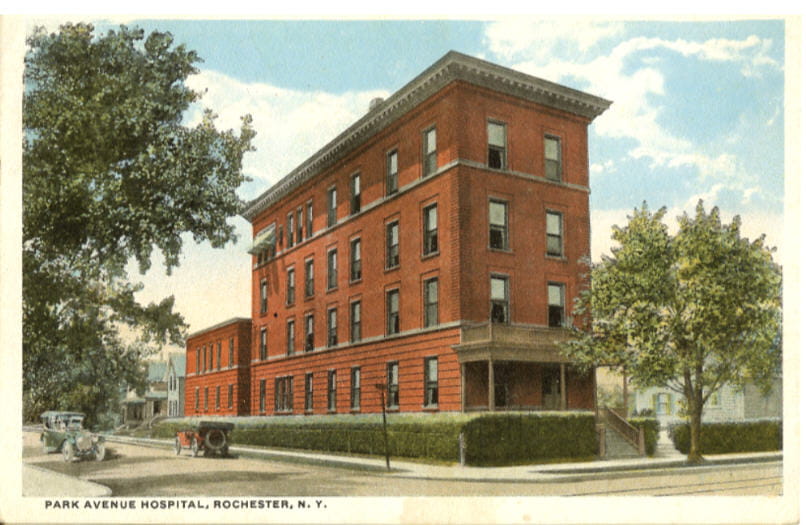
That same year, the Park Avenue Training School for Nurses was chartered by the state and graduated its first class of Nurses three years later. The school remained in operation until 1949. Many of the graduates remained at Park Avenue Hospital and other local hospitals during their nursing careers.
In the late 1940s, the Rochester Regional Hospital Council’s plan for hospital development called for the consolidation of Park Avenue and Rochester General Hospitals, with Park Avenue’s Staff being shifted to the New Proposed North Park Hospital. Over the next few years, administrative disagreements led to a corporate merging of Rochester General and North Park Hospital Corporations without Park Avenue Hospital. Rochester General would complete the project alone, culminating with the opening of the Rochester General Hospital’s Northside Division on Portland Avenue in 1956. Referred to as “Northside Hospital”, this campus remains today as the Flagship of Rochester General Health System.

Park Avenue Hospital continued to grow and serve the community until June 7, 1971 when the Rochester Regional Hospital Council and the Health Council of Monroe County authorized the closing of Park Avenue Hospital and the restructuring of the New hospital named Park Ridge Hospital in the Northwest section of Monroe County in Greece. Park Avenue Hospital ceased admissions on August 27, 1975.
The new Park Ridge Hospital opened in 1975 and continues to serve the community as part of the Unity Health System. In 1997, Park Ridge joined with the St. Mary’s Hospital of Rochester to form Unity Health System and in 2006, Park Ridge Hospital was renamed Unity Hospital marking its 90th year of operation.
The last hospital in this retrospective came about as a result of a 1910 report by Abraham Flexner on the state of medical schools in the nation. Flexner’s findings identified the need for a new approach to medical education. A decade later, Flexner approached the president of the University of Rochester, Dr. Benjamin Rush Rhees with the idea of establishing a medical center at the university that would be based on three principles: The new facility would incorporate scientific inquiry through dedicated research, it would be an institution of learning for the medical students, and it would serve as a community hospital. Together, Flexner and Dr. Rhees approached Rochester’s philanthropist and founder of Eastman Kodak, George Eastman, with the idea of supporting the innovative project. With Eastman’s support, additional financial support from the Rockefeller Foundation and the daughters of Henry Alvah Strong, the University of Rochester Medical Center was founded in 1921. The medical school opened in 1925 and Strong Memorial Hospital opened the following year as a 250 bed community hospital.
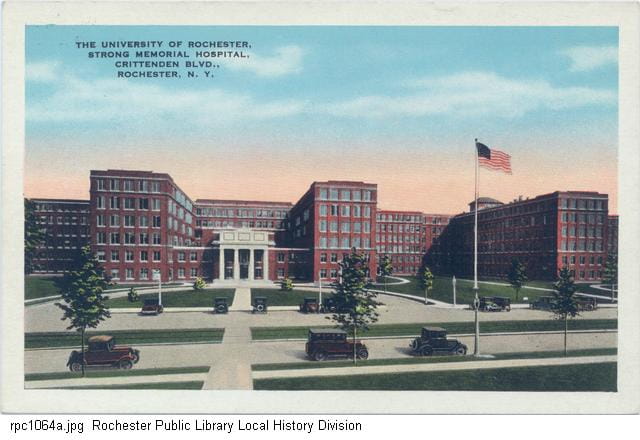
The University of Rochester Medical Center at Strong Memorial Hospital continued to grow over the years and has earned a reputation as a leader in medical research and trauma care in the region. Today Strong operates a 739 bed care center and is consistently ranked as one of America’s Best Hospitals in U.S. News & World Report’s annual survey.
The history of the medical profession in Rochester is founded upon the legacy of the community's past caregivers and the development of these early medical institutions. Although the practice of medicine has changed over the years with the advancements in science and technology, the outstanding reputation and success the present hospitals enjoy is a direct result of the service, dedication, and expertise of the physicians, nurses, administrators, and support personnel of Rochester's early hospitals.
- Bob Dickson
This Research and article is dedicated to the late Rev. Robert F. McNamara, long-time historian and archivist for the Roman Catholic Diocese of Rochester.